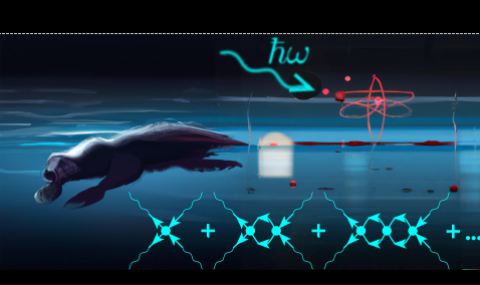Light-coupled arrays of emitters form an inherently open system due to the possibility of spontaneous photon emission into the far field. Interestingly, the decay rate of collective eigenmodes within these emitter arrays can be either enhanced (for superradiant modes) or suppressed (for subradiant modes) when compared to the decay rate of an individual emitter. The development of such collective modes can be described by effective non-Hermitian Hamiltonians, known for their unique properties.
Our initial research focused on the phenomena of super- and sub-radiance within periodic and quasiperiodic arrays of light-coupled semiconductor quantum wells. Within these arrays, we observed that collective enhancement and suppression of emission could occur depending on whether the inter-well spacings were in tune or out of tune with the Bragg condition at the frequency of the exciton inside the quantum wells.
More recently, our research interests have shifted to artificial quantum systems, specifically, arrays of superconducting qubits. In the weak excitation regime these systems share a lot of similarities with the quantum well arrays. However, in a highly excited or driven regime, the lifetime of quantum correlations becomes highly sensitive to the nuances of many-body interactions within the array. This research aims to unlock deeper understanding of these quantum interactions and their potential implications for quantum technologies.

Selected publications
Reviews
- E. Ivchenko and A. Poddubny, "Resonant diffraction of electromagnetic waves from solids (a review)", Phys. Solid State 55, 905-923 (2013)
- A.N. Poddubny, E.L. Ivchenko, "Photonic quasicrystalline and aperiodic structures", Physica E 42, 1871–1895 (2010)
Theory
Qubit arrays
- Alexander N. Poddubny, "Interaction-induced analog of a non-Hermitian skin effect in a lattice two-body problem", Phys. Rev. B 107, 045131 (2023)
- Alexander N. Poddubny, "Driven anti-Bragg subradiant correlations in waveguide quantum electrodynamics", Phys. Rev. A 106, L031702 (2022)
- Alexander V. Poshakinskiy and Alexander N. Poddubny, "Quantum Borrmann effect for dissipation-immune photon-photon correlations", Phys. Rev. A 103, 043718 (2021)
- Alexander V. Poshakinskiy and Alexander N. Poddubny, “Dimerization of many-body subradiant states in waveguide quantum electrodynamics”, Phys. Rev. Lett. 127, 173601 (2021)
- Alexander N. Poddubny, “Quasiflat band enabling subradiant two-photon bound states”, Phys. Rev. A 101, 043845 (2020)
- Gleb Fedorovich, Danil Kornovan, Alexander Poddubny, and Mihail Petrov, "Chirality-driven delocalization in disordered waveguide-coupled quantum arrays", Phys. Rev. A 106, 043723 (11pp) (2022)
Quantum well arrays
- A. V. Poshakinskiy, A. N. Poddubny, and S. A. Tarasenko, "Reflection of short polarized optical pulses from periodic and aperiodic multiple quantum well structures", Phys. Rev. B 86, 205304 (2012)
- A. N. Poddubny, L. Pilozzi, L., M.M. Voronov, and E.L. Ivchenko, "Exciton-polaritonic quasicrystalline and aperiodic structures", Phys. Rev. B 80, 115314(2009).
- A. N. Poddubny, L. Pilozzi, M. M. Voronov, and E. L. Ivchenko, "Resonant Fibonacci quantum well structures in one dimension", Phys. Rev. B 77, 113306 (2008)
- M. Voronov, E. Ivchenko, V. Kosobukin, A. Poddubny, "Specific features in reflectance and absorbance spectra of one-dimensional resonant photonic crystals", Physics of the Solid State, 49(9) 1792-1802(11) (2007)
In collaboration with experimentalists
Superconducting qubits
- Jan David Brehm, Richard Gebauer, Alexander Stehli, Alexander N. Poddubny, Oliver Sander, Hannes Rotzinger, Alexey V. Ustinov, "Slowing down light in a qubit metamaterial", Appl. Phys. Lett. 121, 204001 (2022)
- Jan David Brehm, Alexander N. Poddubny, Alexander Stehli, Tim Wolz, Hannes Rotzinger, Alexey V. Ustinov, “Waveguide Bandgap Engineering with an Array of Superconducting Qubits”, Quantum Materials 6, 10 (2021),
Semiconductor quantum wells
- Y. Chen, N. Maharjan, Z. Liu, M. L. Nakarmi, V. V. Chaldyshev, E. V. Kundelev, A. N. Poddubny, A. P. Vasil’ev, M. A. Yagovkina and N. M. Shakya, "Resonant optical properties of AlGaAs/GaAs multiple-quantum-well based Bragg structure at the second quantum state", J. Appl. Phys. 121, 103101 (2017),
- J. Hendrickson, B. C. Richards, J. Sweet, G. Khitrova, A. N. Poddubny, E. L. Ivchenko, M. Wegener, and H. M. Gibbs, "Excitonic polaritons in Fibonacci quasicrystals", Opt. Express 16, 15382-15387 (2008)


